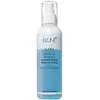What's inside
What's inside
 Key Ingredients
Key Ingredients

 Benefits
Benefits

 Concerns
Concerns

 Ingredients Side-by-side
Ingredients Side-by-side

Water
Skin ConditioningCyclopentasiloxane
EmollientPEG-12 Dimethicone
Skin ConditioningLactic Acid
BufferingCetrimonium Chloride
AntimicrobialPhenyl Trimethicone
Skin ConditioningSodium Benzoate
MaskingPolyquaternium-4
Hydrolyzed Keratin
HumectantDimethiconol
EmollientBenzophenone-4
UV AbsorberParfum
MaskingPropylene Glycol
HumectantPolysilicone-18 Cetyl Phosphate
Phenoxyethanol
PreservativePotassium Sorbate
PreservativeSaccharomyces/Magnesium Ferment
CI 42090
Cosmetic ColorantSaccharomyces/Iron Ferment
Skin ConditioningSaccharomyces/Zinc Ferment
Skin ConditioningSaccharomyces/Copper Ferment
Skin ConditioningSaccharomyces/Silicon Ferment
Skin ConditioningHexyl Cinnamal
PerfumingLimonene
PerfumingLinalool
PerfumingWater, Cyclopentasiloxane, PEG-12 Dimethicone, Lactic Acid, Cetrimonium Chloride, Phenyl Trimethicone, Sodium Benzoate, Polyquaternium-4, Hydrolyzed Keratin, Dimethiconol, Benzophenone-4, Parfum, Propylene Glycol, Polysilicone-18 Cetyl Phosphate, Phenoxyethanol, Potassium Sorbate, Saccharomyces/Magnesium Ferment, CI 42090, Saccharomyces/Iron Ferment, Saccharomyces/Zinc Ferment, Saccharomyces/Copper Ferment, Saccharomyces/Silicon Ferment, Hexyl Cinnamal, Limonene, Linalool
Water
Skin ConditioningPEG-12 Dimethicone
Skin ConditioningQuaternium-80
Polysorbate 20
EmulsifyingCetrimonium Chloride
AntimicrobialHydrolyzed Keratin
HumectantPanthenol
Skin ConditioningPhenoxyethanol
PreservativeCaprylyl Glycol
EmollientHexylene Glycol
EmulsifyingPotassium Sorbate
PreservativeHydrolyzed Silk
HumectantCitric Acid
BufferingSymphytum Officinale Leaf Extract
Skin ConditioningAnthemis Nobilis Flower Extract
MaskingMentha Piperita Leaf Extract
Skin ConditioningLavandula Angustifolia Extract
Skin ConditioningSalvia Sclarea Extract
AntiseborrhoeicParfum
MaskingBenzyl Benzoate
AntimicrobialButylphenyl Methylpropional
PerfumingHydroxyisohexyl 3-Cyclohexene Carboxaldehyde
MaskingHexyl Cinnamal
PerfumingSilica
AbrasiveAlumina
AbrasiveTitanium Dioxide
Cosmetic ColorantCI 19140
Cosmetic ColorantCI 16035
Cosmetic ColorantWater, PEG-12 Dimethicone, Quaternium-80, Polysorbate 20, Cetrimonium Chloride, Hydrolyzed Keratin, Panthenol, Phenoxyethanol, Caprylyl Glycol, Hexylene Glycol, Potassium Sorbate, Hydrolyzed Silk, Citric Acid, Symphytum Officinale Leaf Extract, Anthemis Nobilis Flower Extract, Mentha Piperita Leaf Extract, Lavandula Angustifolia Extract, Salvia Sclarea Extract, Parfum, Benzyl Benzoate, Butylphenyl Methylpropional, Hydroxyisohexyl 3-Cyclohexene Carboxaldehyde, Hexyl Cinnamal, Silica, Alumina, Titanium Dioxide, CI 19140, CI 16035
Ingredients Explained
These ingredients are found in both products.
Ingredients higher up in an ingredient list are typically present in a larger amount.
This ingredient is a preservative, antimicrobial, and emulsifier. It is often used in cosmetics for its ability to cleanse, condition, and reduce static.
Cetrimonium chloride is a quaternary ammonium salt, meaning it has a water-soluble structure.
Hexyl Cinnamal is a fragrance ingredient with a similar scent to jasmine. It can be naturally found in chamomile essential oil.
This ingredient is a known EU allergen and may sensitize the skin. The EU requires this ingredient to be listed separately on an ingredients list.
Hexyl Cinnamal is not water soluble but is soluble in oils.
Learn more about Hexyl CinnamalHydrolyzed Keratin is derived from keratin. Keratin is a large protein that is naturally found in our hair and skin.
Studies show keratin is able to seal broken hair cuticles, helping to prevent split ends and breakage.
As a humectant, hydrolyzed keratin helps draw moisture from the air to your hair and skin. This helps keep your skin and hair hydrated.
Learn more about Hydrolyzed KeratinParfum is a catch-all term for an ingredient or more that is used to give a scent to products.
Also called "fragrance", this ingredient can be a blend of hundreds of chemicals or plant oils. This means every product with "fragrance" or "parfum" in the ingredients list is a different mixture.
For instance, Habanolide is a proprietary trade name for a specific aroma chemical. When used as a fragrance ingredient in cosmetics, most aroma chemicals fall under the broad labeling category of “FRAGRANCE” or “PARFUM” according to EU and US regulations.
The term 'parfum' or 'fragrance' is not regulated in many countries. In many cases, it is up to the brand to define this term.
For instance, many brands choose to label themselves as "fragrance-free" because they are not using synthetic fragrances. However, their products may still contain ingredients such as essential oils that are considered a fragrance by INCI standards.
One example is Calendula flower extract. Calendula is an essential oil that still imparts a scent or 'fragrance'.
Depending on the blend, the ingredients in the mixture can cause allergies and sensitivities on the skin. Some ingredients that are known EU allergens include linalool and citronellol.
Parfum can also be used to mask or cover an unpleasant scent.
The bottom line is: not all fragrances/parfum/ingredients are created equally. If you are worried about fragrances, we recommend taking a closer look at an ingredient. And of course, we always recommend speaking with a professional.
Learn more about ParfumPEG-12 Dimethicone is a type of water-soluble silicone. It has skin conditioning and hydrating properties.
According to a manufacturer, this ingredient's stability is decreased by strong acid or alkali.
Phenoxyethanol is a preservative that has germicide, antimicrobial, and aromatic properties. Studies show that phenoxyethanol can prevent microbial growth. By itself, it has a scent that is similar to that of a rose.
It's often used in formulations along with Caprylyl Glycol to preserve the shelf life of products.
Potassium Sorbate is a preservative used to prevent yeast and mold in products. It is commonly found in both cosmetic and food products.
This ingredient comes from potassium salt derived from sorbic acid. Sorbic acid is a natural antibiotic and effective against fungus.
Both potassium sorbate and sorbic acid can be found in baked goods, cheeses, dried meats, dried fruit, ice cream, pickles, wine, yogurt, and more.
You'll often find this ingredient used with other preservatives.
Learn more about Potassium SorbateWater. It's the most common cosmetic ingredient of all. You'll usually see it at the top of ingredient lists, meaning that it makes up the largest part of the product.
So why is it so popular? Water most often acts as a solvent - this means that it helps dissolve other ingredients into the formulation.
You'll also recognize water as that liquid we all need to stay alive. If you see this, drink a glass of water. Stay hydrated!
Learn more about Water